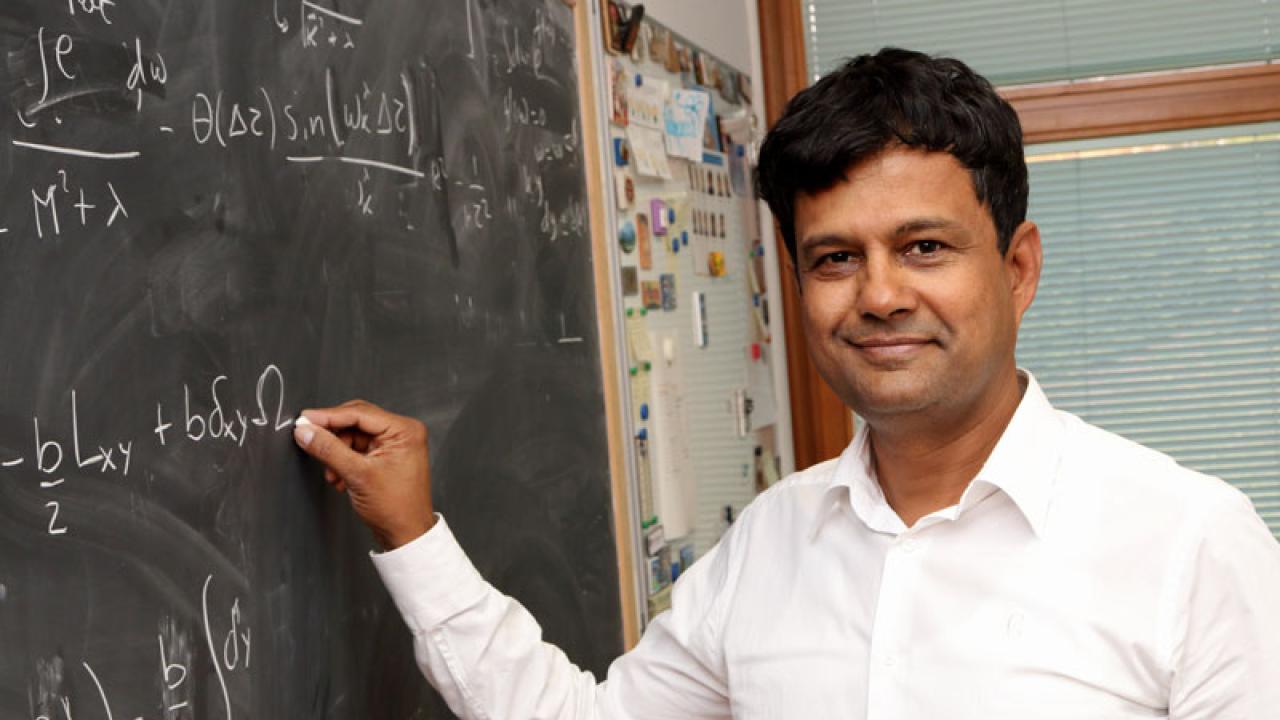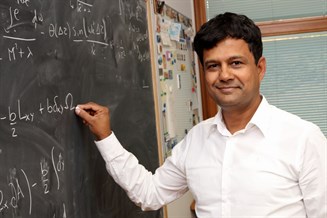
The new head of ICTP’s High Energy, Cosmology, and Particle Physics section, Atish Dabholkar, appreciates that his research is a continuation of the line of research of ICTP founder Abdus Salam. Dabholkar works on string theory and black hole physics, building on the work on unification for which Salam was awarded a Nobel Prize in Physics in 1979. “Salam’s work was an important milestone leading to the questions I’m working on now,” says Dabholkar. “It’s quite a privilege for me to be the head of this section.” Now, in addition to research, Dabholkar is also carrying out Salam's mission of international cooperation through science.
 Dabholkar grew up in a small village in India, one of the developing countries that Salam aimed to support in its scientific capacity development when ICTP was founded in 1964. “My parents were from the post-freedom generation in India, excited about rebuilding the nation. They were both professors at a newly founded rural university that was a bit like ICTP: 'development through education' was a motto of theirs. There was an element of idealism." As a teenager, he fell in love with theoretical physics. “I didn't really know what I was getting into,” he smiles. “But it was glamorous, kind of sexy.”
Dabholkar grew up in a small village in India, one of the developing countries that Salam aimed to support in its scientific capacity development when ICTP was founded in 1964. “My parents were from the post-freedom generation in India, excited about rebuilding the nation. They were both professors at a newly founded rural university that was a bit like ICTP: 'development through education' was a motto of theirs. There was an element of idealism." As a teenager, he fell in love with theoretical physics. “I didn't really know what I was getting into,” he smiles. “But it was glamorous, kind of sexy.”
Dabholkar's academic history includes stints at some of the world's top research institutions, including IIT, Princeton, Harvard, Caltech, CNRS, Stanford, and CERN. The research community in India has since rapidly grown and is now thriving, as well as several other countries, including China and Brazil; Dabholkar was part of that scientific boom. After ten years as a professor at the Tata Institute of Fundamental Research in Mumbai, family reasons took him back to Europe. Now ICTP offers another way to help build scientific capacity in India and around the world. “ICTP’s global mission really appeals to me,” Dabholkar says.
Of the extensive work that has characterized his career, Dabholkar points to what is now known as the Dabholkar-Harvey spectrum as one of the pieces of work he is most proud of. “It was some of the first work I did as a grad student, so it was a bit like a first love,” he says. "In superstring theory the fundamental constituents of matter are imagined to be one-dimensional strings. We found supersymmetric solitonic solutions, which are lumps of energy that keep their shape without dispersing. We suggested that the solitons could somehow be 'dual' or equivalent to the fundamental strings themselves." These solutions played a crucial role in the subsequent discovery of duality symmetries in string theory. “It was kind of ahead of its time—it was nice to contribute before the revolution happened." This lead to his later work on quantum black holes, for which he was awarded the Bhatnagar Prize, India's most prestigious science prize.
As a student, Dabholkar’s studies led him to the Spring School in String Theory, a high profile international school at ICTP. Coming full circle, he later returned as a lecturer and is now an organizer. Schools like these put Dabholkar in a unique place to continue and expand his section’s capacity-building efforts. “Salam’s vision of the ICTP as an international hub for scientists remains valid today, but can perhaps be implemented a bit differently for different countries, taking into account changing realities," Dabholkar says. "We’re trying to develop different types of research collaborations. For countries like China, Brazil, or India, which are no longer developing countries in the same sense as at the time of Salam, it could now be more as an equal partnership."
String theory may not be testable in the immediate future, but that does not deter Dabholkar. “String theory is a work in progress, but one of the things that convinces me we’re on the right track is that we’ve learned some very deep and nontrivial things about quantum gravity.” While general relativity describes gravity at very large distances, quantum mechanics describes nature at very small distances. Combining the two into a coherent quantum theory of gravity has proved to be an outstanding challenge for physicists. String theory offers a potential solution, even though it’s not currently confirmable through experiment.
“It’s kind of like being on an archeological expedition,” Dabholkar says. “We’ve uncovered a really imposing and magnificent structure in the middle of nowhere. Everything is exquisitely carved and precisely placed. We may not know what else is there and if there even is a sanctum sanctorum that reveals the secrets of unification and quantum gravity. But it would be foolish to stop digging. ” Quantum aspects of black holes and holography continue to fascinate Dabholkar, and lately he has also been interested in gravity at long distances. “You could say that I’m interested in the long and the short of quantum gravity,” Dabholkar quips.
Much of his research gets done in cafes, ICTP bar's among them. “One of my recent papers started with a conversation in a cafe in Paris with a renowned number theorist Don Zagier, now at ICTP. It was just on a hunch that I had invited him to a conference in Paris. Our conversations led to a very fruitful collaboration together with Sameer Murthy from King's College," says Dabholkar. The team uncovered connections between the physics of quantum black holes and the mathematics of Ramanujan from a century ago. “It’s the kind of thing that I would not have imagined possible— to connect Ramanujan's mysterious mock theta functions with black holes and to write a paper with a math theorem in it,” he laughs.
As the new head of the HECAP section, Dabholkar is looking forward to hiring new young faculty for the section, to being proactive about recruiting talented associates and collaborators in the developing world, and to raising additional funds to support more activities and participants. “I’m very happy being at the ICTP,” Dabholkar says. “It’s a fantastic organization with a very high level of science and a unique global mission.”
---- Kelsey Calhoun
















